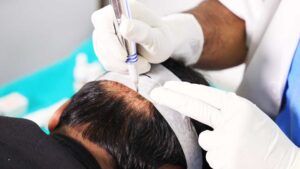
Hair loss is an unfortunate occurrence that many individuals dread, but for some, it is an unavoidable reality. Those who experience hair loss often find themselves in a state of uncertainty, unsure of which treatment option to pursue or which one would be most effective for them.
In an attempt to address their hair loss, individuals often resort to self-treatment and experiment with various remedies recommended by loved ones or advertised products. However, it is unfortunate that most of these cosmetic products do not provide any significant benefits in controlling hair loss.
If you are seeking to determine the most suitable treatment modality for your hair loss, it is imperative to consult a doctor. During this consultation, you will have the opportunity to address any doubts or concerns you may have.
During the initial consultation, your scalp will undergo a thorough examination, allowing the doctor to assess the cause of your hair loss and determine the extent of baldness.
Let us now explore the different treatment options available for hair loss and when they should be preferred.
Pattern baldness
Pattern baldness, also known as androgenic baldness, is a common form of hereditary hair loss that affects both males and females. However, the way it presents itself differs between the two genders. In males, pattern baldness is characterized by the development of bald patches in the vertex region and a receding hairline. As the hair loss progresses, a band of hair remains on the sides and back of the head while the bald area expands. On the other hand, pattern baldness in females typically does not involve complete baldness. Instead, it often manifests as central thinning and widening of the hair parting in the later stages.
Medications for hair loss:
There are two medications currently available in the market for the treatment of hair loss. The first one is Minoxidil, which is an over-the-counter topical lotion. Its purpose is to reduce the progression of hair loss and thicken existing hairs. While Minoxidil has been found to be beneficial for hair loss, it is important to note that the results may only be temporary and could revert back once the medication is discontinued.
The second medication is Finasteride, which is prescribed orally. Its main goal is to slow down the progression of hair loss and promote hair growth. Similar to Minoxidil, Finasteride may provide temporary benefits, and the results may relapse if the medication is stopped. It is worth mentioning that both medications come with certain side effects and are not recommended for women of reproductive age due to contraindications.
Hair transplant
Hair transplantation is a minimally invasive cosmetic surgical procedure that involves harvesting a specific number of hair follicles from the donor area and transplanting them to the desired bald area. The donor areas can include the back and sides of the head, chest, axilla, pubic area, or beard area.
After discussing the limitations of medications as a long-term solution for hair loss, it is important to highlight that hair transplant is currently considered the ultimate solution. There are several benefits associated with this procedure:
- Permanent treatment option: The results of a hair transplant are permanent because only permanent hair roots are harvested and transplanted.
- Cost-effective: Although the initial cost of a hair transplant may be higher, it is a one-time investment that provides long-term benefits.
- High success rate: When performed by an expert surgeon, the success rate of a hair transplant can be nearly 99%.
- Short recovery period: The recovery period after a hair transplant is relatively short and easy, with complete healing typically occurring within 7-10 days.
- Hassle-free: Transplanted hair does not require any special maintenance, making the procedure completely hassle-free.
Overall, hair transplant offers a permanent solution for hair loss with a high success rate, making it a cost-effective and hassle-free option.
Which one is better for you?
- If a patient is experiencing hair loss without an obvious bald spot, it is important for them to seek medical attention. This includes symptoms such as losing more than 100 hairs per day and finding them in the sink, on pillows, or in the comb. Starting with medication therapy is recommended to accurately assess the stability of the hair loss and rule out any underlying causes. This approach allows for verification of the benefits before considering a hair transplant as a final resort.
- When all available treatment options for hair loss have been exhausted without any noticeable improvement, a hair transplant treatment becomes a preferable choice. Despite trying various medications, if there has been no progress, a hair transplant can be considered as an alternative.
- While there is no specific age recommendation for hair transplantation, individuals under the age of 25 may have unstable hair loss that progresses at an unpredictable rate. It is advisable to wait at least three years for the hair loss to stabilize before considering a hair transplant as a therapy option. Additionally, at a young age, the underlying cause of hair loss may not be apparent, which could lead to an unsuccessful hair transplant. However, if the hair loss appears to be stable after three years, a hair transplant can be considered even at a younger age.
Medispa clinic is well-known for its exceptional hair transplant in India. Our commitment to delivering natural and undetectable results is unmatched. We have invested in state-of-the-art equipment that adheres to American standards and utilizes cutting-edge technology, ensuring significant improvements in the outcomes. Dr. Suneet Soni, a renowned surgeon, is highly skilled in performing hair transplants and consistently achieves ideal results at a reasonable hair transplant cost in India. Moreover, his artistic vision and dexterity contribute to the unique quality of his approach in creating natural-looking hairlines.







